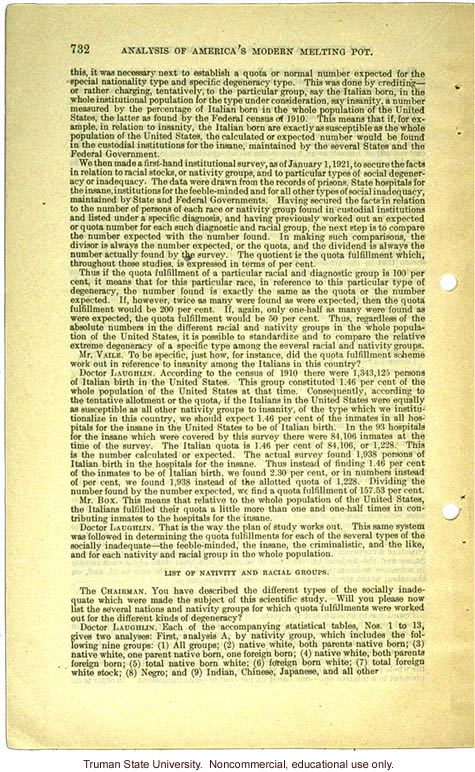732 Analysis of America's Modern Melting Pot.
this, it was necessary next to establish a quota or normal number expected for the special nationality type and specific degeneracy type. This was done by crediting - or rather charging, tentatively, to the particular group, say the Italian born, in the whole institutional population for the type under consideration, say insanity, a number measured by the percentage of Italian born in the whole population of the United States, the latter as found by the Federal census of 1910. This means that if, for example, in relation to insanity, the Italian born are exactly as susceptible as the whole population of the United States, the calculated or expected number would be found in the custodial institutions for the insane, maintained by the several States and the Federal Government.
We then made a first-hand institutional survey, as of January 1, 1921, to secure the facts in relation to racial stocks, or nativity groups, and to particular types of social degeneracy of inadequacy. The data were drawn from the records of prisons, State hospitals for the insane, institutions for the feeble-minded and for all other types of social inadequacy, maintained by State and Federal Governments. Having secured the facts in relation to the number of persons of each race or nativity group found in custodial institutions and listed under a specific diagnosis, and having previously worked out an expected or quota number for each such diagnostic and racial group, the next step is to compare the number expected with the number found. In making such comparisons, the divisor is always the number expected, or the quota, and the dividend is always the number actually found in the survey. The quotient is the quota fulfillment which, throughout these studies, is expressed in terms of per cent.
Thus if the quota fulfillment of a particular racial and diagnostic group is 100 per cent, it means that for this particular race, in reference to this particular type of degeneracy, the number found is exactly the same as the quota or the number expected. If, however, twice as many were found as were expected, then the quota fulfillment would be 200 per cent. If, again, only one-half as many were found as were expected, the quota fulfillment would be 50 per cent. Thus, regardless of the absolute numbers in the different racial and nativity groups in the United States, it is possible to standardize and to compare the relative extreme degeneracy of a specific type among the several racial and nativity groups.
Mr. Vaile. To be specific, just how, for instance, did the quota fulfillment scheme work out in reference to insanity among the Italians in this country?
Doctor Laughlin. According to the census of 1910 there were 1,343,125 persons of Italian birth in the United States. This constituted 1.46 per cent of the whole population of the United States at the time. Consequently, according to the tentative allotment or the quota, if the Italians in the United States were equally as susceptible as all other nativity groups to insanity, of the type which we institutionalize in this country, we should expect 1.46 per cent of the inmates in all hospitals for the insane in the United States to be of Italian birth. In the 93 hospitals for the insane which were covered by this survey there were 84,106 inmates at the time of the survey. The Italian quota is 1.46 per cent of 84, 106 or 1,228. This is the number calculated or expected. The actual survey found 1,938 persons of Italian birth in the hospitals for the insane. Thus instead of finding 1.46 per cent of the inmates to be of Italian birth, we found 2.30 per cent, or in numbers instead of per cent, we found 1,938 instead of the allotted quota of 1,228. Dividing the number found by the number expected, we find a quota fulfillment of 157.53 per cent.
Mr. Box. This means that relative to the whole population of the United States, the Italians fulfilled their quota a little more than one and one-half times in contributing inmates to the hospitals for the insane.
Dr. Laughlin. That is the way the plan of the study works out. This same system was followed in determining the quota fulfillment for each of the several types of the socially inadequate - the feeble-minded, the insane, the criminalistic, and the like, and for each nativity and racial group in the whole population.
List of Nativity and Racial Groups.
The Chairman. You have described the different types of the socially inadequate which were made the subject of this scientific study. Will you please now list the several nations and nativity groups for which quota fulfillments were worked out for the different kinds of degeneracy?
Doctor Laughlin. Each of the accompanying statistical tables, No. 1 to 13, gives two analyses: First, analysis A, by nativity group, which includes the following nine groups: (1) All groups; (2) native white, both parents native born; (3) native white, one parent native born, one foreign born; (4) native white, both parents foreign born; (5) total native born white; (6) foreign born white; (7) total foreign white stock; (8) Negro; and (9) Indian, Chinese, Japanese, and all other.


